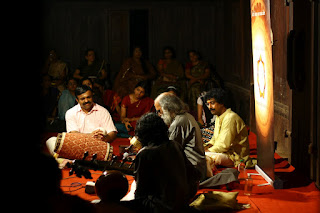


 Please see result of "Carnatic Icon Junior 2012" ,the Kacheri competition of NAADAvidyaaLAYAM held on January
Please see result of "Carnatic Icon Junior 2012" ,the Kacheri competition of NAADAvidyaaLAYAM held on January  26th
26th
 രാഗസാന്ദ്രമായ ഒരു സന്ധ്യ
രാഗസാന്ദ്രമായ ഒരു സന്ധ്യ 








The ambience of Tanjavur Ammaveedu located at West Fort,Thiruvananthapuram was another great success and we thank Mr.Raghu of Mithranikethan for allotting such a beautiful location for us.
Photo credits to Anilkumar ,Sasikumar and Subhash Kumarapuram











 Some parts I feel some resemblense in structure of OOTHUKKAD krithis !!!
Some parts I feel some resemblense in structure of OOTHUKKAD krithis !!!http://www.youtube.com/watch?v=3kIey2rq0kc&feature=related

Tirujnana Sambandhar composed his first song in age three !!
listen to the song thodudaiya sevian ..
http://www.youtube.com/watch?v=-OT2RCgAvVA&feature=related
According to the legend, the saint Sambandar lived in the 8th century in the small town of Sirkali, in the very south of India. It is told that he already met Shiva in his childhood. Sambandar is said to have received the gift of seeing Shiva with his own eyes and composing hymns in his honour. With Shiva's help, he also performed many miracles.
Sambandar's hymns are testimony to profound piety. He venerated Shiva and his female companions with limitless devotion. Sambandar lost himself to Shiva, for Shiva had stolen his heart. At one moment Sambandar could be shaken with fear, at the next in deep ecstasy. He trembled and cried, danced and sang. Such intensely emotional religious devotion is what gives this poet his mystical quality.
Sambandar's hymns are sung to this day in all the Shaivite temples of south India. They were incorporated into the standard temple liturgy. Through his songs, Sambandar connects people and gods beyond the borders of time and place.

Let’s keep our Music alive
NAADAvidyaaLAYAM
SangeethaSatsangam,the musical get together
on all second Saturdays
Programme schedule of this month
On 14th January 2012@4.30pm to 8.30pm
Venue: Tanjavur Ammaveed(Mithranikethan City Centre),
Gate next to Arumana Hospital, West Fort,
Thiruvananthapuram
Sessions:
1 : Abhyasam- Practice (SwaraSadhakam)
2 : Anubhavam- Carnatic Music Concert (Veena)
3.SahaBhojanam- Light refreshment
4 : Abhyasanam- Demonstration
5 : AnuSandhaanam - Follow-up discussion and interaction
Theme of the month:
Discovering the moods of Hindustani Ragas in Carnatic Music
Musician: Veena Maestro Sri. Ananthapadmanabhan
Mridangam : Sri.Mavelikkara Rajeev
Ghatam : Adichallur അനില്കുമാര്
Participation is free.
You are cordially invited. Sharp time schedule will be followed . So we request you to reach before time to avoid missing of celestial moods.
For Details contact : 9447374646


Born in1934, in the heartland of Punjab at Shamchaurasi, district Hoshiarpur, Ustad Salamat Ali Khan belonged to a family of traditional musicians representing the Shamchaurasi gharana. It is claimed that the gharana was founded in the 16th century by Mian Chand Khan and Mian Suraj Khan who were contemporaries of Mian Tansen at the court of Mughal emperor Akbar. Prior to the emergence of Ustad Nazakat Ali Khan and Ustad Salamat Ali Khan as exponents of khayal, the gharana specialised in the dhrupad form of singing and was particularly renowned for its tradition of duet performances known as jugalbandi. Mian Karim Bukhsh Majzoob, Ustad Ahmed Ali Khan, Ustad Niaz Hussain Shami, and Salamat Ali Khan’s father Ustad Vilayat Ali Khan were some of the illustrious members of the Shamchaurasi gharana.
 Oothukkadu Venkata Subba Iyer was a saintly composer of Tamil Nadu the 18th century.
Oothukkadu Venkata Subba Iyer was a saintly composer of Tamil Nadu the 18th century. believed that Lord Krishna remained in the dancing posture in Oothukkadu.
believed that Lord Krishna remained in the dancing posture in Oothukkadu. ated
ated